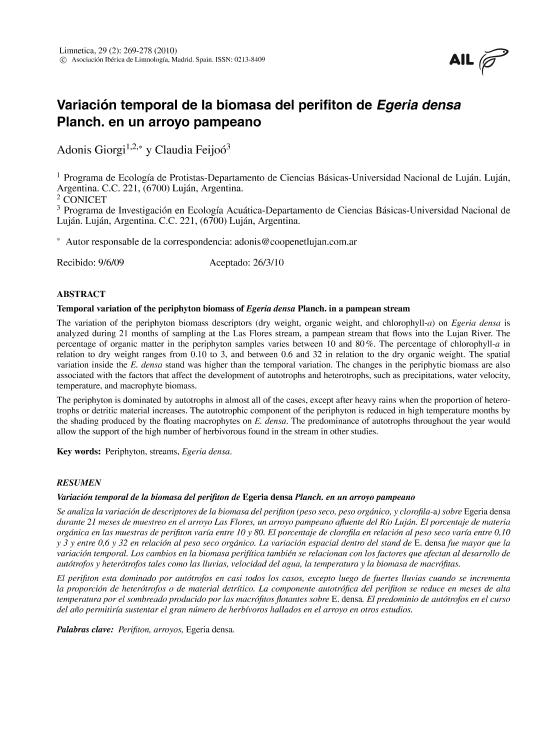Artículo
Se analiza la variación de descriptores de la biomasa del perifiton (peso seco, peso orgánico, y clorofila-a) sobre Egeria densa durante 21 meses de muestreo en el arroyo Las Flores, un arroyo pampeano afluente del Río Luján. El porcentaje de materia orgánica en las muestras de perifiton varía entre 10 y 80. El porcentaje de clorofila en relación al peso seco varía entre 0.10 y 3 y entre 0.6 y 32 en relación al peso seco orgánico. La variación espacial dentro del stand de E. densa fue mayor que la variación temporal. Los cambios en la biomasa perifítica también se relacionan con los factores que afectan al desarrollo de autótrofos y heterótrofos tales como las lluvias, velocidad del agua, la temperatura y la biomasa de macrófitas. El perifiton esta dominado por autótrofos en casi todos los casos, excepto luego de fuertes lluvias cuando se incrementa la proporción de heterótrofos o de material detrítico. La componente autotrófica del perifiton se reduce en meses de alta temperatura por el sombreado producido por las macrófitos flotantes sobre E. densa. El predominio de autótrofos en el curso del año permitiría sustentar el gran número de herbívoros hallados en el arroyo en otros estudios. The variation of the periphyton biomass descriptors (dry weight, organic weight, and chlorophyl!-a) on Egeria densa is analyzed during 21 months of sampling at the Las Flores stream, a pampean stream that flows into the Lujan River. The percentage of organic matter in the periphyton samples varies between 10 and 80 %. The percentage of chlorophyl!-a in relation to dry weight ranges from 0.10 to 3, and between 0.6 and 32 in relation to the dry organic weight. The spatial variation inside the E. densa stand was higher than the temporal variation. The changes in the periphytic biomass are also associated with the factors that affect the development of autotrophs and heterotrophs, such as precipitations, water velocity, temperature, and macrophyte biomass. The periphyton is dominated by autotrophs in almost al! of the cases, except after heavy rains when the proportion of hetero-trophs or detritic material increases. The autotrophic component of the periphyton is reduced in high temperature months by the shading produced by the floating macrophytes on E. densa. The predominance of autotrophs throughout the year would allow the support of the high number of herbivorous found in the stream in other studies.
Variación temporal de la biomasa del perifiton de Egeria densa Planch: En un arroyo pampeano
Título:
Temporal variation of the periphyton biomass of Egeria densa Planch: In a pampean stream
Fecha de publicación:
07/2010
Editorial:
Asociación Española de Limnología
Revista:
Limnetica
ISSN:
0213-8409
e-ISSN:
1989-1806
Idioma:
Español
Tipo de recurso:
Artículo publicado
Clasificación temática:
Resumen
Palabras clave:
Perifiton
,
Arroyos
,
Egeria densa
Archivos asociados
Licencia
Identificadores
Colecciones
Articulos(SEDE CENTRAL)
Articulos de SEDE CENTRAL
Articulos de SEDE CENTRAL
Citación
Giorgi, Adonis David Nazareno; Feijoó, Claudia Silvina; Variación temporal de la biomasa del perifiton de Egeria densa Planch: En un arroyo pampeano; Asociación Española de Limnología; Limnetica; 29; 2; 7-2010; 269-278
Compartir




